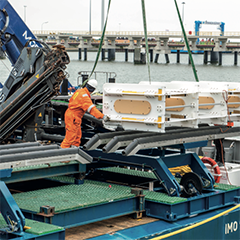While more than seven decades have now passed since the end of WWII, the remnants still remain in the North Sea today. It is common practice for Unexploded Ordnance (UXO) to be found during offshore projects, with potential to pose a threat to offshore work and vessels, particularly when laying pipelines and cables in the seabed. PES wanted to find out more about this new improved technology, which will save time and therefore money. Plus it will also be safer for the operators, in what can be a dangerous occupation.
Clearance campaigns commenced after the war, which ended 73 years ago, but thousands of unexploded ordnances are still present.
As the number of offshore marine projects continues to increase, demand for an efficient, cost-effective and risk-based approach for the mitigation of UXO is a priority for offshore teams. Survey work is an essential first step in UXO clearance, with survey specialists providing the tools to locate, identify and manage potential UXO.
Now in its ninth decade and with more than 50 years’ subsea-specific experience, N-Sea offers a wide range of assurance and maintenance services to the oil and gas, renewable, and civil contracting industries, having truly evolved into a leading integrated subsea infrastructure services provider.
With bases in the Netherlands, Aberdeen, Dubai, Mumbai and Norwich, N-Sea employs 150 personnel. Its Aberdeen base was formed in 2014, to firmly establish the company’s presence in the Northern and Central North Sea and encompasses both office facilities at Aberdeen Harbour, and a workshop/product development facility based at Dyce.
This knowledge and wealth of experience has been utilised in the development of MagSense, which has been used in numerous projects since it was first launched. Through its creation and introduction, a vertical gradiometer array, specifically designed for highly accurate UXO campaigns within the oil and gas and renewables sectors, N-Sea has opened up new possibilities for the industry.
Developed in-house by N-Sea in collaboration with EIVA, the system has been designed to collect and record high resolution data in magnetically noisy subsea environments and hostile conditions, delivering unprecedented accuracy, greater efficiency and enhanced safety in the detection of UXO. It features manoeuvrability and flexibility, customised to reflect modern-day imperatives in offshore construction, and adapt to individual client needs.


























